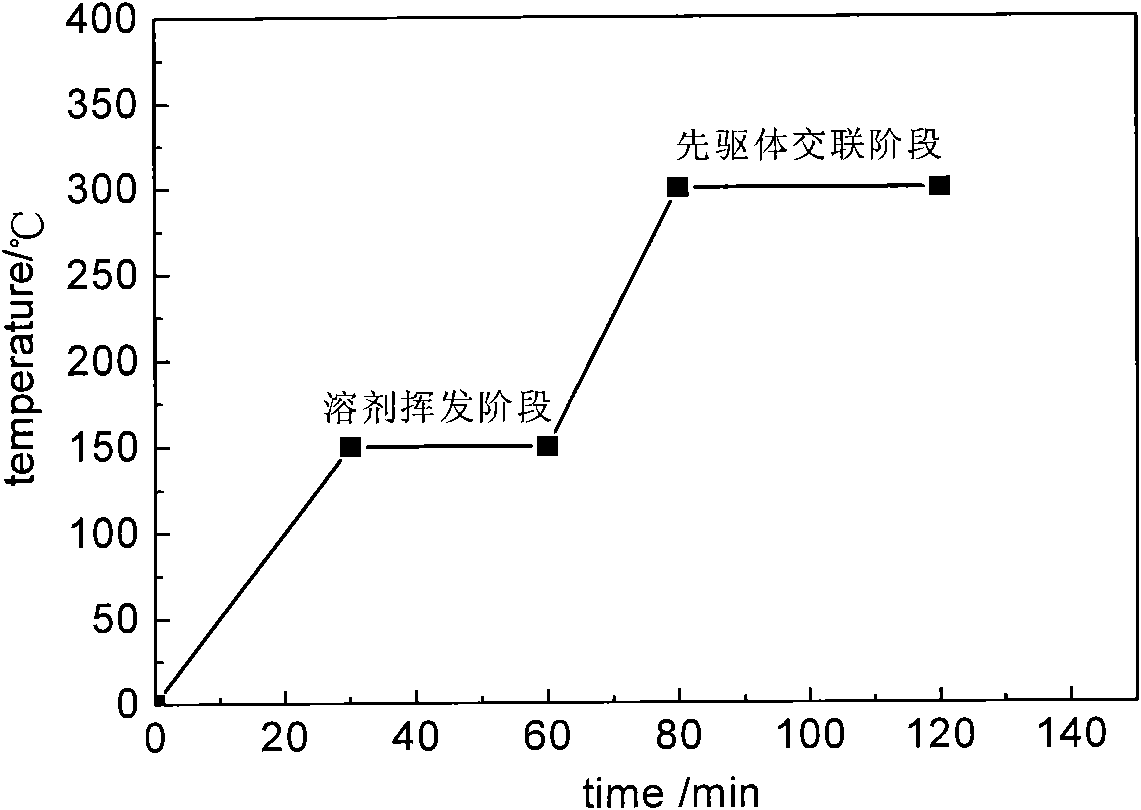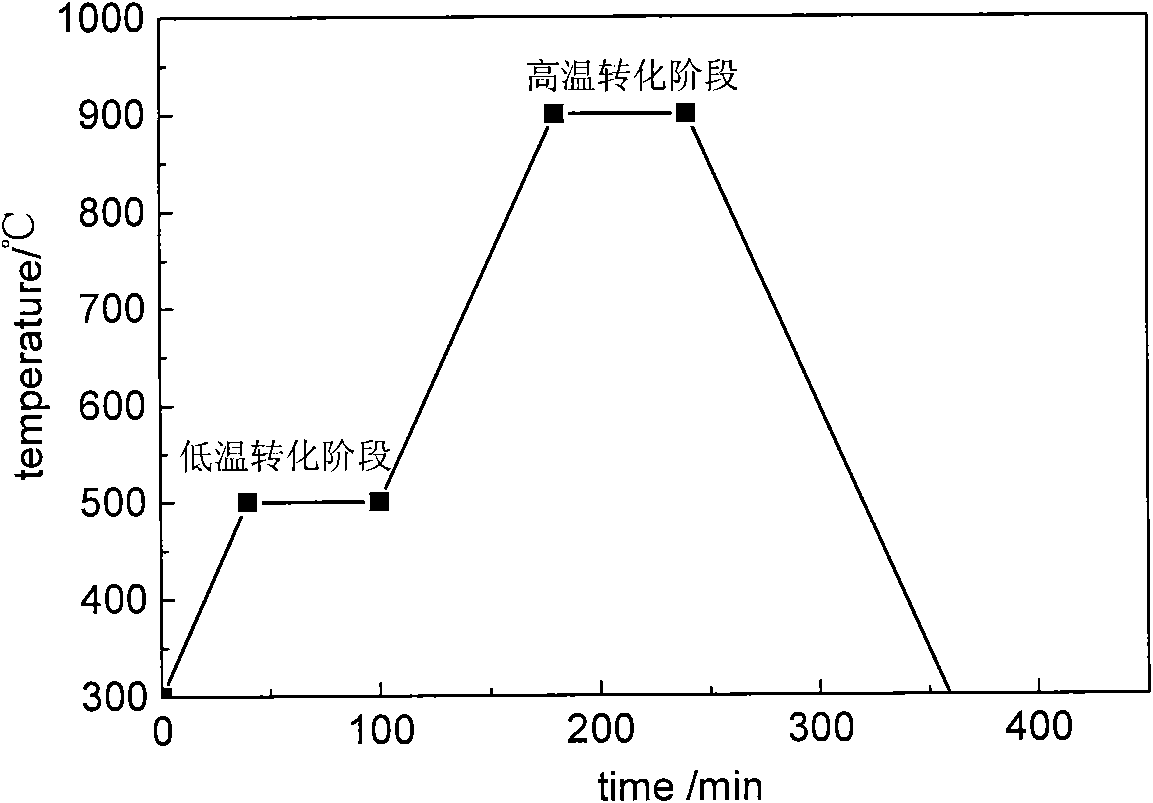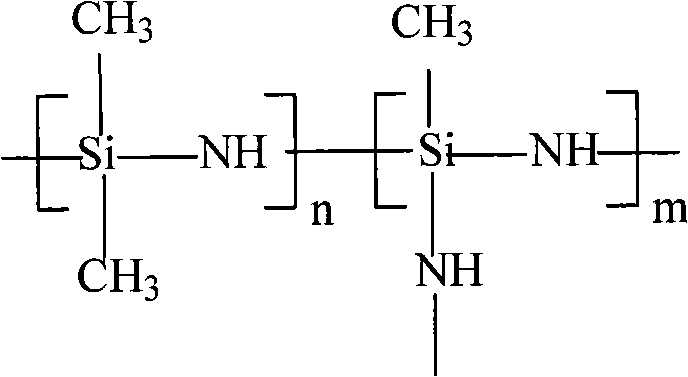Method for preparing insulating heat conducting ceramic coating from polymer precursor
A technology of insulating thermal conductivity and ceramic coating, applied in the field of insulating thermal conductivity coating and ceramic coating, can solve the problem of insignificant effect, and achieve the effect of good insulation performance, excellent thermal conductivity and excellent thermal shock resistance.
- Summary
- Abstract
- Description
- Claims
- Application Information
AI Technical Summary
Problems solved by technology
Method used
Image
Examples
Embodiment 1
[0039] Take 1Kg of polysilazane with a molecular weight between 1000 and 5000, add 200g of aluminum nitride filler, 50g of tantalum nitride filler, 100g of boron nitride filler, silicon carbide Filler 200g, boron carbide filler 100g, silicon powder 5g, boron powder 5g, after stirring, add xylene 60g, continue stirring until uniform. The slurry was then repeatedly ground for 3 to 5 times with a three-roll mill. Spray the obtained slurry on the surface of a surface-treated 1mm-thick copper sheet with a spray gun, heat-treat it at 100°C to 300°C for 2 hours in a vacuum state, and then pass it into a nitrogen atmosphere, start slowly heating up to 900°C, and heat it at 900°C ℃ for 1 hour, and then slowly lower the temperature to room temperature to obtain a ceramic coating with copper as the base material, with a thickness of about 80-100 μm. According to the experimental test, the breakdown voltage can reach 10KV (AC), and the insulation resistance is greater than 1×10 10 Ω, th...
Embodiment 2
[0041] Take 1Kg of polysilazane with a molecular weight between 1000 and 5000, add 300g of aluminum nitride filler, 50g of tantalum nitride filler, 100g of boron nitride filler, silicon carbide Filler 200g, boron carbide filler 200g, silicon powder 8g, boron powder 8g, after stirring, add xylene 80g, continue stirring until uniform. The slurry was then repeatedly ground for 3 to 5 times with a three-roll mill. Spray the obtained slurry on the surface of a surface-treated 1mm-thick copper sheet with a spray gun, heat-treat it at 100°C to 300°C for 2 hours in a vacuum state, then pass it into an ammonia atmosphere, and start slowly heating up to 900°C. Keep the temperature at 900°C for 1 hour, and then slowly cool down to room temperature to obtain a ceramic coating with copper as the base material, with a thickness of about 80-100 μm. According to the experimental test, the breakdown voltage can reach 10KV (AC), and the insulation resistance is greater than 1×10 10 Ω, thermal...
Embodiment 3
[0043] Take 1Kg of polysilazane with a molecular weight between 1000 and 5000, add 200g of aluminum nitride filler, 50g of tantalum nitride filler, 100g of boron nitride filler, silicon carbide Filler 200g, boron carbide filler 200g, silicon powder 8g, boron powder 8g, after stirring, add xylene 80g, continue stirring until uniform. The slurry was then repeatedly ground for 3 to 5 times with a three-roll mill. Spray the obtained slurry on the surface of a surface-treated 1mm-thick aluminum sheet with a spray gun, heat-treat it at 100°C to 300°C for 2 hours in a vacuum state, pass through an ammonia atmosphere, and start to slowly heat up to 500°C, and then Keep the temperature at 500°C for 2 hours, and then slowly cool down to room temperature to obtain a ceramic coating with aluminum as the base material, with a thickness of about 80-100 μm. According to the experimental test, the breakdown voltage can reach 10KV (AC), and the insulation resistance is greater than 1×10 10 Ω...
PUM
| Property | Measurement | Unit |
|---|---|---|
| particle diameter | aaaaa | aaaaa |
| particle size | aaaaa | aaaaa |
| particle size | aaaaa | aaaaa |
Abstract
Description
Claims
Application Information
 Login to View More
Login to View More - R&D
- Intellectual Property
- Life Sciences
- Materials
- Tech Scout
- Unparalleled Data Quality
- Higher Quality Content
- 60% Fewer Hallucinations
Browse by: Latest US Patents, China's latest patents, Technical Efficacy Thesaurus, Application Domain, Technology Topic, Popular Technical Reports.
© 2025 PatSnap. All rights reserved.Legal|Privacy policy|Modern Slavery Act Transparency Statement|Sitemap|About US| Contact US: help@patsnap.com



